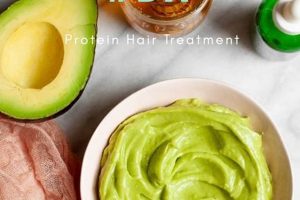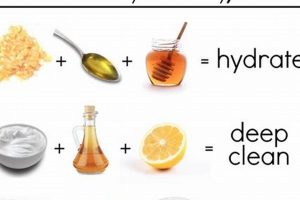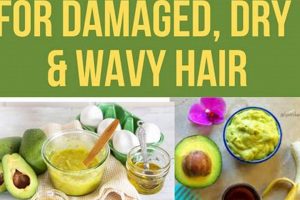The creation of homemade solutions designed to shield hair from thermal damage caused by styling tools is a growing area of interest. These formulations, crafted with readily available ingredients, aim to minimize the detrimental effects of heat exposure on hair structure and appearance. An example is a mixture of argan oil, coconut oil, and shea butter, combined to create a protective barrier before using a hairdryer or flat iron.
The significance of safeguarding hair from heat damage lies in preserving its integrity and preventing issues like dryness, breakage, and split ends. Historically, individuals have sought natural remedies to maintain hair health. The current surge in popularity of these protective methods reflects a desire for cost-effective and personalized hair care approaches, often emphasizing natural or organic components.
Subsequent discussion will delve into specific ingredient options, formulation techniques, application methods, and considerations regarding the effectiveness and suitability of various preparations. A thorough examination will also address the potential drawbacks and limitations associated with creating and utilizing such products.
DIY Heat Protection
Implementing homemade heat protection requires careful attention to detail to ensure effectiveness and minimize potential adverse effects.
Tip 1: Prioritize Ingredient Selection: Carefully consider the properties of each component. Oils with high smoke points, such as grapeseed or avocado oil, are generally more suitable than those with lower smoke points, like olive oil, to prevent burning and potential hair damage.
Tip 2: Control Concentration: Excessive oil concentration can weigh hair down, resulting in a greasy appearance. Start with small amounts and gradually increase as needed, focusing on the ends and avoiding the scalp.
Tip 3: Even Distribution is Crucial: Ensure the protective mixture is evenly distributed throughout the hair before applying heat. This can be achieved through thorough combing or brushing after application.
Tip 4: Temperature Regulation: Minimize the heat setting on styling tools. Lower temperatures reduce the risk of damage, even with protective measures in place.
Tip 5: Conduct a Strand Test: Prior to applying any homemade protectant to the entire head, perform a strand test on a small, inconspicuous section of hair to assess compatibility and prevent unforeseen reactions.
Tip 6: Avoid Overuse: Daily application of even a well-formulated protectant can lead to buildup. Use only when heat styling is necessary, and clarify hair regularly to remove residue.
Tip 7: Be Mindful of Hair Porosity: High porosity hair absorbs moisture quickly, potentially requiring slightly higher concentrations of protectant. Low porosity hair resists moisture, necessitating careful application to avoid buildup.
Proper ingredient selection, controlled application, and mindful temperature regulation are vital for successful and safe use of homemade heat protectants. Careful experimentation and observation will help determine the optimal formulation and technique for individual hair types and styling needs.
The subsequent sections will address the potential for specialized formulations based on specific hair types and styling techniques.
1. Ingredient Smoke Points
The effectiveness and safety of homemade heat protectants are intrinsically linked to the smoke points of the constituent ingredients, particularly oils. Smoke point refers to the temperature at which an oil begins to break down and emit smoke. Utilizing oils with smoke points below the operating temperature of hair styling tools such as flat irons or curling irons can lead to thermal degradation of the oil itself. This degradation not only diminishes the intended protective effect but may also result in the deposition of damaging residues on the hair shaft. For instance, olive oil, with a relatively low smoke point, is generally unsuitable for high-heat styling, whereas grapeseed oil, boasting a higher smoke point, presents a more appropriate choice.
Understanding ingredient smoke points allows for the formulation of heat protectants that maintain their structural integrity under thermal stress. Continued exposure to degraded oils can contribute to hair damage, including dryness, brittleness, and breakage. Formulators must therefore prioritize ingredients that remain stable and protective at the temperatures commonly employed in hair styling. Consider a scenario where coconut oil, with a moderate smoke point, is used excessively during high-heat styling. The resultant smoke and residue may actually exacerbate the heat damage that the protectant was designed to prevent.
In summation, careful consideration of ingredient smoke points is paramount to the success of homemade heat protectants. Neglecting this aspect can compromise the efficacy of the product and potentially inflict further harm to the hair. Choosing ingredients with high smoke points provides a critical foundation for creating a protectant that effectively shields hair from thermal damage.
2. Oil-Water Emulsification
Oil-water emulsification is a critical process in the creation of effective homemade heat protectants. Many beneficial oils for hair, such as argan or jojoba, do not readily mix with water, which is often a key component for even distribution and application. Emulsification ensures a stable and homogenous mixture, allowing for uniform coverage and enhanced protective properties.
- Formation of Stable Mixtures
Emulsification stabilizes inherently immiscible substances. It involves dispersing one liquid as fine droplets within another, preventing separation. In a homemade heat protectant, emulsifiers like beeswax or certain natural gums can bind water and oils, creating a consistent solution that avoids oily patches or uneven distribution. For example, a spray-on heat protectant relies on a well-formed emulsion to prevent nozzle clogging and ensure a fine, even mist.
- Enhanced Distribution and Absorption
An emulsion facilitates the even application of oil-based protectants across the hair shaft. Water acts as a carrier, allowing the oils to spread thinly and coat each strand thoroughly. This is particularly important for heat protectants, as consistent coverage minimizes the risk of hot spots and uneven thermal damage. Improper emulsification can lead to concentrated oil deposits, resulting in greasy hair and diminished protection in other areas. An example is applying a non-emulsified oil blend; clumping occurs, leaving sections vulnerable.
- Improved Product Stability and Shelf Life
Emulsification contributes to the longevity of homemade heat protectants. Properly emulsified mixtures are less prone to separation, spoilage, and ingredient degradation. This is particularly important for formulations containing water, which can promote microbial growth. Emulsifiers, and sometimes preservatives, help maintain product integrity and prevent the proliferation of harmful bacteria or mold. Without stable emulsification, a homemade protectant could quickly become unusable or even detrimental to hair health.
- Control of Texture and Consistency
Emulsification allows for greater control over the texture and consistency of the final product. Depending on the desired application method (spray, cream, serum), the oil-water ratio and type of emulsifier can be adjusted to achieve the optimal texture. For instance, a lightweight spray requires a thin, easily dispersible emulsion, while a thicker cream necessitates a more viscous and stable formulation. This adaptability is essential for creating user-friendly and effective heat protectants that cater to different hair types and styling preferences. Consider the impact of the correct emulsion of the hair type; fine hair will not become weighted down.
The significance of oil-water emulsification in homemade heat protection stems from its ability to create stable, well-distributed, and long-lasting products. By effectively combining water and oil-based ingredients, emulsification allows for consistent thermal protection and promotes overall hair health during heat styling. Without it, creating a quality product is unachievable.
3. Application Technique
The effectiveness of homemade heat protectants is inextricably linked to the chosen application technique. Even the most carefully formulated protective mixture will fail to deliver its intended benefits if applied improperly. The primary objective of any application method is to ensure uniform distribution of the protectant across the entirety of the hair shaft, thereby creating a consistent barrier against thermal damage. Uneven application leaves certain areas vulnerable to intense heat, potentially leading to localized dryness, breakage, and textural irregularities. Consider the instance of applying a homemade serum solely to the surface of the hair, neglecting the inner layers. This practice would leave the interior strands susceptible to damage, despite the superficial protection afforded to the outer layer.
Several application methods are commonly employed, each with its own set of advantages and limitations. Spray application offers the benefit of ease and speed, but may result in uneven coverage if not performed meticulously. Cream or serum application allows for more targeted control, but requires thorough sectioning and careful massage to ensure even distribution. Oil application is straightforward, but prone to over-saturation, which can weigh down the hair and diminish volume. Regardless of the method selected, the key lies in dividing the hair into manageable sections and applying the protectant in a consistent and systematic manner, working from root to tip. Real-world application includes the proper usage on thin hair vs thick hair in terms of quantity and distribution.
In conclusion, application technique constitutes a crucial component of homemade heat protection. Improper application undermines the benefits of even the best formulations, while a conscientious and methodical approach maximizes their effectiveness. Understanding the nuances of different application methods and tailoring them to individual hair types and styling practices is essential for achieving optimal thermal protection and maintaining overall hair health. Recognizing the challenges can foster better formulations, and a link is strengthened to the broader theme for informed hair care.
4. Hair Type Specificity
The effectiveness of any homemade heat protectant is significantly influenced by the specific characteristics of the hair to which it is applied. Hair exhibits diverse structural and chemical properties that dictate its response to thermal styling and the efficacy of protective measures. Formulating a one-size-fits-all solution is often inadequate; customized approaches are crucial for optimizing protection and minimizing potential adverse effects.
- Porousity Considerations
Hair porosity, or the hair’s ability to absorb and retain moisture, is a critical determinant in heat protectant formulation. High-porosity hair, characterized by a more open cuticle structure, tends to absorb moisture rapidly but also loses it quickly. Consequently, heat protectants designed for high-porosity hair should incorporate humectants to attract and retain moisture during styling. Conversely, low-porosity hair, with a tightly closed cuticle, resists moisture absorption. Heat protectants for this hair type should be lightweight and easily absorbed to prevent buildup and weigh-down. An example is a heavier, cream-based protectant overwhelming low-porosity hair, leaving it greasy and flat, while a light, spray-on formula may not provide sufficient protection for high-porosity hair.
- Hair Texture Variations
Hair texture, ranging from fine to coarse, dictates the density and diameter of individual hair strands. Fine hair is more susceptible to heat damage due to its lower mass, requiring lightweight protectants that provide adequate protection without weighing the hair down. Coarse hair, with its greater diameter, can tolerate heavier formulations but may require more thorough application to ensure even coverage. Consider that a rich oil-based serum might be ideal for protecting thick, coarse hair, while a water-based spray would be more appropriate for fine, delicate strands. Neglecting these textural differences can lead to ineffective protection or undesirable cosmetic outcomes.
- Curl Pattern Influences
Curly and coily hair types possess unique structural complexities that necessitate specialized heat protection strategies. The natural bends and curves in curly hair create variations in strand thickness and cuticle exposure, making it more prone to dryness and breakage. Heat protectants for curly hair should provide intense hydration and lubrication to minimize friction and prevent damage during styling. Furthermore, the application technique should emphasize even distribution throughout the curl pattern, ensuring that all strands are adequately protected. Incorrect application may result in heat damage on the outer curves or the internal hair structure.
- Chemical Processing History
Chemically treated hair, such as hair that has been colored, permed, or relaxed, is inherently more vulnerable to heat damage. These processes often compromise the hair’s structural integrity, leaving it more porous, brittle, and prone to breakage. Heat protectants for chemically treated hair should incorporate strengthening and reparative ingredients, such as proteins and amino acids, to help rebuild the hair’s internal structure and improve its resilience to thermal stress. Applying heat without tailored protection will increase vulnerability. Neglecting to account for chemical processing history can lead to severe and irreversible hair damage.
These factorsporosity, texture, curl pattern, and chemical processing historyunderscore the need for hair type-specific heat protectant formulations. Recognizing and addressing these individual differences is essential for maximizing the effectiveness of homemade heat protectants and promoting long-term hair health. This detailed approach is crucial in tailoring protection and maximizing outcomes, which is related to the broader theme of customizing hair care.
5. Hold and Texture
The characteristics of hold and texture imparted by homemade thermal protectants are critical considerations in their formulation and application. An effective solution balances the need for thermal defense with the maintenance of desirable hair aesthetics, as undue rigidity or an undesirable surface feel can negate the benefits of heat styling.
- Impact of Ingredients on Style Retention
The selection of ingredients significantly influences the degree of style retention achieved after heat styling. Components such as natural gums or resins, included to provide a protective barrier, may also impart a degree of hold. An excessive concentration of these ingredients can create stiffness or an unnatural rigidity, hindering desired movement and flexibility. Conversely, insufficient levels may lead to rapid style degradation, negating the intended effects of heat styling. A balanced formulation ensures adequate thermal protection without compromising style integrity. A real-world example involves the use of flaxseed gel as a heat protectant; while providing some hold, it can also create a sticky or crunchy texture if not properly diluted or applied. This impact directly affects the utility of heat styling.
- Texture Modification Through Formulation
Homemade heat protectants can inadvertently alter the texture of the hair, influencing its overall appearance and manageability. Oil-based formulations, while offering superior thermal protection, can weigh down finer hair types, resulting in a greasy or limp appearance. Conversely, water-based solutions may lack the necessary emollients to adequately protect coarser hair, leaving it dry and brittle. The incorporation of ingredients such as silicones or lightweight polymers can impart a smoother, more refined texture, but requires careful consideration to avoid product buildup. The formulator must also consider the balance in texture to avoid an oily or sticky feeling. An example is using too much shea butter, which can make hair feel heavy and greasy, versus a lightweight oil blend that provides protection without altering the hair’s natural texture.
- Influence on Hair Volume and Body
The volume and body of the hair are often affected by the application of heat protectants. Heavy formulations can flatten the hair, reducing volume and diminishing overall body. This effect is particularly pronounced in individuals with fine or thin hair. Lightweight formulations or application techniques that focus on the mid-lengths and ends of the hair can minimize this effect. Conversely, some formulations, particularly those containing volumizing polymers, can enhance body and lift, creating a fuller, more voluminous style. This balance directly links formulation to application. For example, a spray-on protectant can distribute more evenly and avoid volume reduction compared to a heavy cream applied at the roots.
- Compatibility with Styling Products
The compatibility of homemade heat protectants with other styling products is an essential consideration. Incompatible formulations can interact negatively, resulting in product buildup, flaking, or an undesirable texture. For example, an oil-based heat protectant may repel water-based styling products, preventing them from adhering to the hair shaft. Likewise, a highly acidic protectant may interfere with the performance of alkaline styling products. Careful selection of ingredients and a thorough understanding of product interactions are necessary to ensure compatibility and maintain the desired style and texture. One potential compatibility issue to avoid is combining a homemade protectant with a styling product leading to increased flaking after drying.
In summary, the aspects of hold and texture are inextricably linked to the overall efficacy and appeal of homemade heat protectants. A carefully balanced formulation, tailored to individual hair types and styling preferences, is crucial for achieving optimal thermal protection without compromising the desired aesthetic. These aspects can affect the use of the “heat protectant for hair diy” to make hair attractive and protect it. The interplay between protection and style is key to user satisfaction.
6. Preservation Methods
The longevity and safety of homemade solutions designed to shield hair from thermal damage hinge directly on appropriate preservation methods. These protectants, often formulated with water-based ingredients or botanical extracts, are susceptible to microbial contamination and degradation, rendering them ineffective or, in some instances, harmful. Without adequate preservation, bacteria, mold, or yeast can proliferate, altering the product’s chemical composition, compromising its protective properties, and potentially causing scalp irritation or allergic reactions. A homemade spray containing aloe vera juice, if left unpreserved, may exhibit signs of spoilage within a few days, indicated by changes in color, odor, or texture.
Implementation of proper preservation techniques is essential for maintaining the integrity of the product and extending its usable lifespan. Natural preservatives, such as vitamin E oil (tocopherol) and rosemary extract, offer antioxidant properties that retard oxidation and prevent rancidity in oil-based components. Broad-spectrum preservatives, such as phenoxyethanol or potassium sorbate, inhibit the growth of bacteria and fungi. The selection of appropriate preservatives depends on the specific ingredients used and the intended shelf life of the product. A formula that combines water and oils requires a robust preservation system to prevent microbial growth at the water-oil interface, where microorganisms thrive. In addition, proper storage such as a cool dark area helps.
In summary, preservation methods are indispensable for ensuring the safety, efficacy, and stability of solutions created to protect hair from heat damage. Neglecting preservation can lead to product spoilage, reduced effectiveness, and potential health risks. Employing appropriate preservatives and adhering to proper storage practices are critical for maintaining the quality and usability of these homemade preparations. The use of effective preservation supports the long-term viability of this DIY approach, linking to the broader goal of safe and sustainable hair care.
7. Heat Tool Compatibility
The efficacy of any homemade heat protectant is inextricably linked to its compatibility with the specific heat tool employed. The protective barrier created must withstand the operational temperature and material composition of the device to mitigate thermal damage effectively. Incongruence between the protectant’s properties and the tool’s characteristics can nullify the intended benefits, potentially exacerbating harm to the hair. For example, a protectant formulated primarily with water may prove ineffective when used with a ceramic flat iron operating at high temperatures, as the water evaporates rapidly, leaving the hair unprotected. The protectant has to work well with the equipment to meet expectations.
Factors such as the heat tool’s material (ceramic, titanium, tourmaline), temperature range, and heating consistency directly influence the protectant’s performance. Ceramic tools, known for even heat distribution, may require lighter, more evenly spread protectants. Conversely, titanium tools, which heat up rapidly and reach higher temperatures, necessitate more robust, heat-resistant formulations. The protectant’s ability to create a durable, even coating that remains stable under the tool’s thermal output is paramount. Proper heat distribution must be ensured. As an example, an oil-based protectant may create excessive smoking or residue buildup on a titanium flat iron operated at its maximum temperature, whereas a lightweight serum may provide adequate protection for a low-heat ceramic curling iron. The composition and properties of the protectant, therefore, cannot be divorced from the instrument used.
In conclusion, the successful implementation of homemade heat protection demands a thorough understanding of heat tool compatibility. Selecting a protectant formulation that aligns with the specific characteristics of the heat styling device is crucial for maximizing its effectiveness and minimizing the risk of thermal damage. By carefully considering the tool’s material, temperature range, and heating consistency, individuals can optimize their homemade heat protection strategies and maintain the health and integrity of their hair. Incompatibilities can render DIY efforts futile; mindful alignment of protectant and tool is essential for success, supporting the broader theme of customized hair care strategies.
Frequently Asked Questions Regarding Homemade Thermal Defense Formulations
The following addresses common inquiries concerning the creation and application of solutions designed to mitigate thermal damage to hair through accessible methods. These questions aim to provide clarity on aspects of ingredient selection, formulation techniques, and potential limitations.
Question 1: Are homemade formulations as effective as commercially available thermal protectants?
The efficacy of DIY formulations is contingent upon ingredient selection, formulation accuracy, and application technique. While certain ingredients possess inherent thermal-protective properties, the concentration and interaction of these elements may not replicate the scientifically optimized performance of commercially manufactured products. Independent testing is generally absent, precluding direct comparison.
Question 2: What constitutes a suitable oil for homemade thermal defense?
An appropriate oil for mitigating thermal damage exhibits a high smoke point, indicating resistance to thermal degradation at styling temperatures. Examples include grapeseed, avocado, and argan oils. Oils with lower smoke points, such as olive or coconut, may degrade and deposit damaging residues upon heating.
Question 3: Can essential oils be incorporated into homemade thermal defense formulations?
The inclusion of essential oils requires careful consideration due to potential volatility and photosensitivity. Certain essential oils may evaporate rapidly under heat, diminishing protective properties. Others may react adversely to sunlight or styling tool materials. Dilution and thorough research are imperative before incorporation.
Question 4: How does hair porosity influence formulation and application?
Hair porosity dictates the absorption rate of ingredients. High-porosity hair, characterized by a more open cuticle, may require more frequent application of hydrating ingredients. Low-porosity hair, with a tightly closed cuticle, benefits from lighter, more easily absorbed formulations to prevent buildup.
Question 5: What are the potential drawbacks of homemade thermal defense formulations?
Potential drawbacks include inconsistent results due to formulation variability, lack of standardized testing, risk of allergic reactions to ingredients, and potential for product buildup. Moreover, the absence of synthetic stabilizers or preservatives may limit shelf life.
Question 6: How frequently should homemade thermal defense formulations be applied?
Application frequency depends on hair type, styling habits, and the formulation’s composition. Over-application may lead to greasy residue or product buildup. Generally, application is recommended only prior to heat styling, with thorough cleansing performed regularly to remove any accumulated residue.
Careful consideration of these inquiries provides a framework for informed decision-making regarding the creation and utilization of homemade thermal defense formulations. Success hinges on meticulous attention to detail and a thorough understanding of hair science.
The following sections will explore advanced formulation techniques and specialized applications.
heat protectant for hair diy.
The preceding investigation reveals that the creation of effective “heat protectant for hair diy” necessitates a rigorous understanding of hair science, ingredient properties, and application methodologies. Success hinges on careful consideration of smoke points, emulsification techniques, and hair type specificity. Preservation methods are paramount for safety and stability, while heat tool compatibility ensures optimal performance.
The utilization of “heat protectant for hair diy” represents a commitment to informed and customized hair care practices. Further research and meticulous experimentation are essential for refining formulations and maximizing their protective capabilities. Continuous vigilance and a dedication to scientific principles will ensure the ongoing efficacy and safety of these homemade thermal defense strategies.







